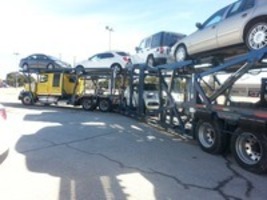Welcome to the exhilarating world of car transportation! Have you ever wondered how those shiny new vehicles magically appear at your local dealership? Behind the scenes, there’s a fascinating and intricate process that ensures every car finds its way from the manufacturer to the showroom floor. In this blog post, we’ll deeply dive into car distribution and explore all the behind-the-scenes action. From ship methods to tracking systems, we’ll uncover how cars are transported to dealerships. So fasten your seatbelts and prepare for an inside look at this captivating journey! How Are Cars Transported To Dealers
How are cars distributed to dealers?
Car distribution to dealerships is a well-coordinated dance between automakers, shipping companies, and logistics experts. The process begins at the manufacturing plant, where cars are produced in large quantities. Once these vehicles roll off the assembly line, they’re assigned to specific dealers based on their orders and regional demand.
To get the cars from the factory to the dealership, various transportation methods come into play. One standard method is using car carriers – those massive trucks you often see on highways with rows of vehicles stacked up like colorful building blocks. These carriers can transport multiple cars simultaneously, making them an efficient choice for long-distance shipments.
But it’s not just about highways and trucking. Cars are also transported by rail and sea depending on their destinations. Rail transport allows more significant quantities of vehicles moved across vast distances efficiently, while shipping via cargo vessels enables manufacturers to reach international markets.
Throughout this intricate journey from point A to point B, advanced tracking systems help ensure that every vehicle stays accounted for. GPS technology allows manufacturers and dealerships alike to monitor each car’s location in real time as it makes its way through transit hubs or customs checkpoints.
What is the process of shipping a car?
Shipping a car involves several steps and meticulous planning to ensure the vehicle reaches its destination safely and promptly. It begins with selecting the appropriate transportation method based on distance, budget, and type of vehicle.
Once the method is chosen, the car is prepared for transport by ensuring it is clean and free from personal belongings or loose items. The next step involves securing the vehicle onto a carrier or trailer using specialized equipment like straps or wheel chocks to prevent movement during transit.
Afterward, paperwork such as insurance documents, registration papers, and delivery instructions are complet. This ensures that all necessary information accompanies the vehicle during transportation.
Upon arrival at its destination, thorough inspections ensure no damages or issues before handing over the keys to their new owners – car dealerships who have eagerly been waiting for their inventory.
In conclusion, shipping a car requires careful planning, preparation, secure loading techniques, and adherence to paperwork procedures. It’s an intricate process that guarantees safe delivery of vehicles from manufacturers/sellers to dealerships across various locations!
How do I track a car in transit to a dealership?
Tracking a car in transit to a dealership can be an exciting and nerve-wracking experience. You’re eagerly awaiting the arrival of your new vehicle, but you also want to stay informed about its progress along the way. Fortunately, many car transportation companies offer tracking services that allow you to keep tabs on your car’s journey.
To track your car, you’ll typically need critical information such as the vehicle identification number (VIN) or the shipping reference number provided by the transportation company. With this information, you can access their online tracking portal or contact customer service for updates.
Once you’ve logged into the tracking portal or spoken with a representative, you’ll see real-time updates on your car’s location and estimated arrival time. Some tracking systems even provide detailed information about each stage of the transportation process, including when it was picked up from its origin point and schedul for delivery.
While tracking your car can alleviate some of the anxiety associated with waiting for its arrival, it’s important to remember that unforeseen circumstances like weather conditions or traffic congestion may cause delays. Nonetheless, having access to this information allows you to plan accordingly and make any necessary arrangements once your vehicle reaches its destination.
Tracking a car in transit provides peace of mind and keeps customers well-informed throughout transportation. It adds transparency and reassurance during an anxious period leading up to receiving one’s new vehicle at the dealership.
Where do most car dealerships get their cars?
When it comes to sourcing vehicles, car dealerships have several options. One standard method is purchasing directly from the manufacturers or through wholesale auctions. Manufacturers often have a network of authorized dealerships that they supply with new vehicles regularly.
Wholesale auctions are another famous avenue for car dealerships to acquire inventory. These auctions combine vehicles from different sources, including trade-ins, lease returns, rental fleets, and repossessions.
In addition to these traditional methods, some car dealerships collaborate with vehicle brokers who specialize in finding specific models or rare vehicles for their clients.
The goal for car dealerships is to ensure they have a diverse inventory that meets the demands and preferences of their customers. By strategically acquiring cars from various sources, they can provide an extensive selection and cater to different budgets and tastes.
In conclusion,
The process of transporting cars to dealerships involves intricate logistics and careful planning. From manufacturing plants to shipping vessels and transport trucks, each step plays a crucial role in ensuring that vehicles reach their destination safely and efficiently.
By understand how cars are distributed to dealers, tracking shipments in transit, and explor where most car dealer source their inventory – we gain insight into the complex world behind getting those shiny new wheels onto showroom floors across the country.
So next time you visit your local dealership or dream about owning a brand-new car straight off the lot, remember all the behind-the-scenes efforts it took so you could drive away happy!
Pros:
Efficient and Fast Delivery: Cars are transport to dealers using specialized transportation methods, ensuring that the delivery process is fast and efficient. This helps dealers to receive their inventory in a timely manner and keep up with demand.
Cost-Effective: The transportation methods used for delivering cars to dealers are often cost-effective, helping dealers save money on shipping costs. This allows them to offer competitive prices for their vehicles.
Protection of Cars: Cars are transport using proper handling and care, ensuring that they reach the dealer in the same condition as when they left the factory. This protects the cars from potential damage during transit.
Wide Range of Transportation Options: There is a wide range of transportation options available for car delivery, including trucks, trains, and ships. This allows dealers to choose the most suitable method based on their location and needs.
Professional Service: Car transportation companies have trained professionals who handle the loading, unloading, and transport of vehicles with expertise. This ensures a smooth and hassle-free delivery process for both the dealer and customer.
Cons:
Potential Delays: Despite efforts to ensure timely delivery, there can be unforeseen delays in transportation due to factors such as weather conditions or traffic congestion. This can affect a dealer’s
FAQs:
Q1. How are cars transported to dealers?
A1. Cars are typically transport on specializ car carrier trucks or by rail. The type of transportation chosen depends on the distance, cost and time constraints of the transport.
Q2. What is the most common way to transport cars to dealers?
A2. The most common way to transport cars to dealers is via car carrier trucks. This is an efficient and cost-effective method for transporting large numbers of vehicles over long distances.
Q3. Are there any special considerations when transporting cars to dealers?
A3. Yes, it is important to ensure the vehicles are safely secured to the truck, and that they are adequately covered to protect them from the elements. Also, some states have laws in place that require certain permits for transporting vehicles across their borders.
Q4. Is it possible to track the shipment during transit?
A4. Yes, most car carrier companies provide tracking services so that you can follow the progress of your shipment online.
Q5. Do car carriers offer insurance for shipments?
A5. Yes, most car carriers offer some form of insurance coverage for shipments. It is important to check with the carrier’s policy to make sure the vehicles are adequately cover in case of any damage or loss.
Features:
1. Shipping via Road: Cars are transport to dealers using enclosed car haulers, which are usually large, flatbed trucks that can carry up to 10 cars at once.
2. Shipping via Rail: Shipping cars via rail is a cost-effective and efficient way of transporting vehicles from the factory to dealerships.
3. Shipping via Air: In some cases, when time is of the essence, cars can be transport via air.
4. Container Shipping: Container shipping is another popular option for transporting cars to dealers. The vehicles are load into containers and then ship via sea.
5. Flatbed Trucks: Flatbed trucks are to transport cars from one dealership to another. They can carry up to five cars at once, making them ideal for large dealerships.
6. Drop Shipping: Drop shipping is a common method of transporting cars from the factory to dealers. This involves the factory shipping the car directly to the dealership, without any stops in between.

